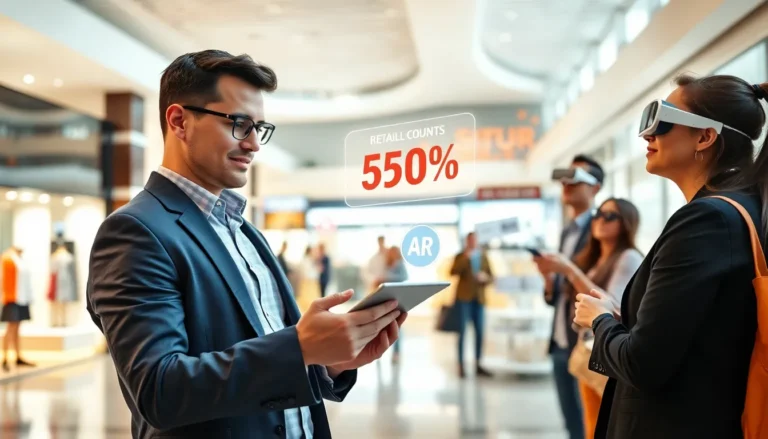Imagine stepping into a world where digital overlays enhance every experience. That’s the magic of augmented reality (AR). Whether you’re envisioning a stunning new app or a revolutionary product, AR startups are capturing the limelight more than ever. In this vibrant landscape, entrepreneurs are tapping into technology that not only dazzles but also transforms how we interact with our environment. So, buckle up. Let’s dive deep into the captivating universe of augmented reality startups and uncover what makes them a game-changer for businesses everywhere.
Table of Contents
ToggleOverview of Augmented Reality Technology

Augmented reality technology bridges the gap between the physical world and the digital universe. By seamlessly integrating computer-generated visuals into a real-world environment, it creates an immersive experience that feels almost magical. Devices such as smartphones and smart glasses serve as portals to this extraordinary realm, allowing users to visualize digital information overlaid on their physical surroundings. Recently, advances in hardware and software have made AR more accessible than ever before, with applications ranging from gaming and education to training and retail. With an ever-expanding toolkit of frameworks and tools, businesses are now leaping into the AR waters, harnessing this technology to capitalize on new opportunities.
Benefits of Augmented Reality for Startups
For startups, diving into AR offers a treasure trove of benefits. First and foremost, it can enhance user engagement and interaction in ways traditional marketing can’t match. Imagine a customer being able to ‘try before they buy’ with a product visualization right in their living room. This level of interactivity not only captures attention but often leads to higher conversion rates.
Besides, AR can drastically reduce the costs associated with training and onboarding. Simulations and visual aids provide new employees with immersive learning experiences that stick.
Another advantage is the potential for differentiation. In a crowded market, businesses leveraging AR stand out, drawing in tech-savvy customers eager for novel experiences. Startups tapping into this technology can craft unique brand identities that resonate with modern consumers who crave innovation.
Key Components of a Successful Augmented Reality Startup
To carve a niche in the augmented reality space, several essential components come into play:
Innovative Concept
Success begins with a pioneering idea that addresses real-world problems. Startups need to brainstorm concepts that leverage AR in ways users haven’t yet experienced. Understanding the target demographic ensures the idea resonates.
User-Centric Design
Creating intuitive and engaging user interfaces is crucial. Fast, seamless experiences keep users coming back. Startups must prioritize user feedback during development cycles to refine their offerings.
Robust Technology Stack
Investing in the right technology is paramount. Startups should choose reliable AR platforms and development tools that align with their project goals. This might include ARKit for iOS, ARCore for Android, or Unity for cross-platform development.
Strategic Partnerships
Collaborating with other companies in technology or creative sectors can yield invaluable resources. Partnerships help speed development times and fortify the startup’s market presence.
Challenges Faced by Augmented Reality Startups
Even though the exciting opportunities, AR startups encounter several hurdles. One significant challenge lies in the rapidly changing technology landscape. Keeping up with advancements and user expectations can feel like a race against time.
Another hurdle is funding. While interest in AR has surged, securing venture capital can be tough. Startups often need to craft compelling pitches that highlight their potential impact and profitability.
Also, user adoption presents its challenges. Many potential users remain unfamiliar with AR technology. Hence, educating them about the benefits of AR applications becomes a priority.
Finally, privacy and data security remain pressing issues. Startups must navigate regulatory concerns while building user trust, ensuring safe data handling practices that protect consumer information.
Case Studies of Successful Augmented Reality Startups
Several startups illustrate the vast potential of augmented reality:
Magic Leap
Founded in 2010, Magic Leap captured attention for its groundbreaking spatial computing technology. The company’s headset allows users to interact with 3D digital objects in real-world environments. Through significant strategic partnerships and a focus on developer engagement, Magic Leap has positioned itself at the forefront of AR innovation.
Houzz
This home design platform utilizes AR to enhance user experience by enabling customers to visualize how products will look in their homes. The ability to overlay furniture and decor in real-time has driven customer engagement and sales, showcasing the practical benefits of AR in retail.
Niantic
Best known for “Pokémon GO,” Niantic has revolutionized mobile gaming by incorporating AR elements. The game’s success exemplifies how engaging gameplay combined with AR can captivate and maintain a wide audience, effectively blending digital entertainment with physical activity.
Future Trends in Augmented Reality
Looking ahead, several trends are poised to shape the future of augmented reality. The rise of 5G technology is expected to enhance AR applications significantly by providing faster data transfer and lower latency. This advancement means more detailed graphics and smoother user experiences.
Also, as wearable technology like smart glasses continues to evolve, AR will become even more integrated into daily life. Consider the possibilities of wearables enhancing work environments or even social interactions in real-time.
Another anticipated trend is the expansion of AR into education and training. As organizations recognize the value of immersive learning experiences, adoption rates in these sectors are likely to skyrocket. Startups focusing on educational AR tools may find abundant opportunities for growth in the coming years.









